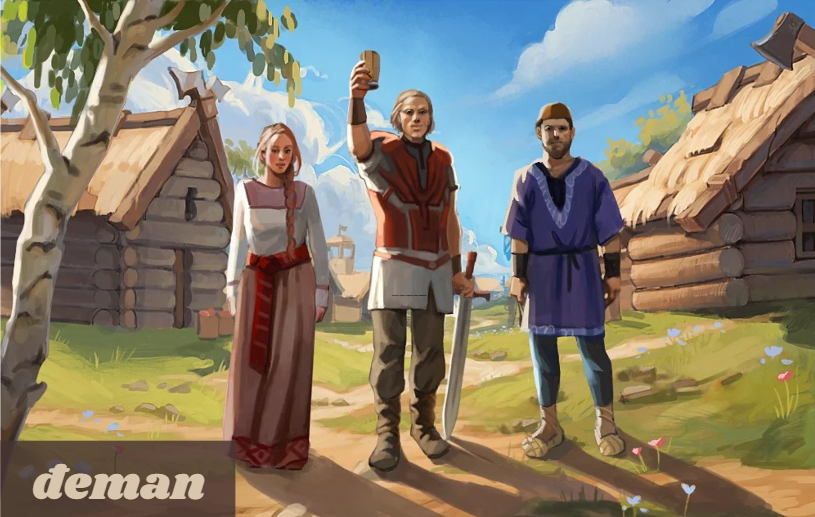Slavic folklore is a treasure trove of mysterious beings, each embodying deep cultural beliefs and a profound respect for nature. Among these mystical figures, Đeman stands out as a captivating figure whose presence weaves together protection, fear, and reverence.
Table of Contents
Known for its guardian role, the Đeman has been a part of Slavic myths for centuries, representing a unique blend of spirituality and respect for the natural world. Whether you’re a folklore enthusiast or someone curious about ancient Slavic traditions, the story of Đeman offers a fascinating look at the enduring power of myth and nature.
Introduction to the Đeman: The Guardian Spirit
The Đeman is a figure steeped in mystery within Slavic mythology. Often described as an ethereal being, it is not an entity of evil but one that operates in the realm of balance. This spirit is seen as a protector, particularly of forests, mountains, and sacred spaces. Unlike spirits that embody darkness or malice, the Đeman serves a more nuanced role, acting as both a guardian and a force that ensures the protection of the earth.
In traditional stories, the Đeman is often depicted as an enigmatic, almost ghostly presence, watching over natural elements. However, it is not just an abstract spirit; it is a character that influences human behaviour. Those who respect nature and live harmoniously with the earth are said to be under the Đeman’s protection, while those who harm the land may face its wrath. It’s a delicate balance of fear and reverence, making the Đeman both a guardian and a figure of caution.
The Origins of Đeman in Slavic Mythology
Slavic Roots of the Đeman Spirit
The origins of the Đeman can be traced back to ancient Slavic tribes, who held nature and its spirits in the highest regard. For these tribes, the forest was not just a place for survival but a sacred space that housed spiritual forces. The Đeman was believed to be one of the many spirits inhabiting these forests—guardians that ensured the land remained pure and untarnished.
Early Slavic peoples, living in the deep forests of Eastern Europe, believed that the natural world was alive with spirits, each governing different aspects of life. Some spirits were benevolent, like the Đeman, while others were more capricious or even malicious. The Đeman, in particular, became associated with the protection of sacred spaces, from forests to the sacred hills that marked the boundaries of tribal territories.
It is said that the Đeman was not just a passive protector but an active force that could influence the weather, the fertility of the land, and even the prosperity of the people. In this sense, it symbolized the belief that humans could not separate themselves from the forces of nature, and their actions—whether good or bad—had consequences.
Evolution of the Đeman Myth Across Cultures
As Slavic culture evolved, so too did the stories of the Đeman. Over time, this spirit became a more localized figure, with variations in how it was depicted across different Slavic regions. In some areas, the Đeman was thought to be a guardian of specific sacred groves or mountains, while in others, it was more broadly seen as the protector of the natural world.
Despite these regional differences, the essence of the Đeman remained consistent: a being that balanced the forces of nature with human activity. Its symbolism grew to represent a dual role—both a guide and a judge. People who lived in harmony with the earth were blessed by its presence, while those who caused harm to nature faced the Đeman’s wrath. The evolution of the Đeman myth underscores the Slavic people’s deep connection to their environment, as well as their respect for the unseen forces that governed it.
The Symbolism of Đeman in Slavic Folklore

In Slavic folklore, the Đeman embodies the complex relationship between humanity and the natural world. It is a symbol of both protection and punishment, a spirit that ensures a balance between human activities and the earth’s resources. The Đeman is often depicted as a mysterious, ethereal figure, sometimes seen as a shadowy presence that lingers in the forest or as a glowing figure that guides travellers on difficult paths.
This duality of protection and fear highlights the Slavic people’s deep respect for nature. The Đeman, as a symbol, suggests that the earth is a sacred entity that must be respected and honoured. Those who take from the land without giving back or those who fail to live in harmony with nature may invoke the Đeman’s wrath. In contrast, those who live in balance with the world around them are protected and guided by the spirit.
Additionally, the Đeman also symbolizes resilience—the spirit of endurance in the face of adversity. Just as the forests survive the harshest winters and the mountains endure through centuries, the Đeman is a reflection of the endurance of both nature and the human spirit. It serves as a reminder that the natural world, while capable of great beauty and bounty, is also unyielding in its demand for respect.
Đeman in Modern Interpretations
Today, the Đeman remains a potent figure in the realm of folklore, particularly in Eastern Europe, where people continue to tell stories of this mysterious protector spirit. In some modern interpretations, the Đeman has been reimagined as a figure representing environmentalism, standing as a symbol of the need to protect our natural world. In literature, film, and art, the Đeman is sometimes depicted as a more complex character, caught between its role as a guardian spirit and its responsibility to punish those who harm the earth.
In some contemporary retellings, the Đeman’s story is used as a cautionary tale about the consequences of environmental destruction. These modern interpretations highlight the enduring relevance of the Đeman as a symbol of the natural world’s power and fragility.
Why the Đeman Endures in Slavic Culture

The enduring presence of the Đeman in Slavic culture can be attributed to the deep spiritual connection Slavic peoples have with nature. The myths surrounding the Đeman reflect a worldview in which humanity is not separate from the earth but deeply intertwined with it. This ancient belief system still resonates today, particularly as environmental concerns grow worldwide.
The Đeman serves as a reminder that the earth is both a giver and a judge. It is a protector for those who live in balance with nature but a formidable force for those who harm it. As modern societies face growing environmental challenges, Đeman’s story becomes more relevant than ever, reminding us of the ancient wisdom that still holds: we must respect and protect the earth to secure our future.
FAQs about Đeman
What is the Đeman spirit in Slavic mythology?
The Đeman is a protective spirit in Slavic mythology, commonly linked to safeguarding forests, mountains, and holy sites. It represents both guardianship and dread, rewarding those who honor nature and punishing those who desecrate it.
Where did the Đeman myth originate?
The Đeman originates from early Slavic tribes, who believed in spirits inhabiting the natural world. It became a figure of reverence and protection for those living in harmony with nature.
Is the Đeman a benevolent or malevolent spirit?
The Đeman is a spirit of balance. It is neither purely benevolent nor malevolent but rather a force that ensures harmony between humans and the earth. It protects those who respect nature and punishes those who exploit it.
How is the Đeman represented in modern culture?
In modern interpretations, the Đeman is often seen as a symbol of environmentalism and a reminder of the consequences of environmental harm. It remains a powerful figure in literature, art, and folklore.
Conclusion: The Enduring Legacy of Đeman
The Đeman is a powerful symbol within Slavic folklore, representing the complex relationship between humanity and the natural world. Its role as a guardian spirit underscores the importance of balance and respect for the earth. In ancient Slavic cultures, the Đeman was seen as a force of protection, keeping the sacred spaces of nature safe from harm. Today, its legacy continues to inspire a renewed appreciation for the environment and a deeper understanding of our interconnectedness with the world around us.
Whether viewed as a supernatural entity or a symbol of environmental consciousness, the Đeman remains a significant figure in Slavic mythology. Its enduring power highlights the timeless connection between nature and spirituality, offering valuable lessons for modern-day life.




